History Highlight: The Egyptian Gateway
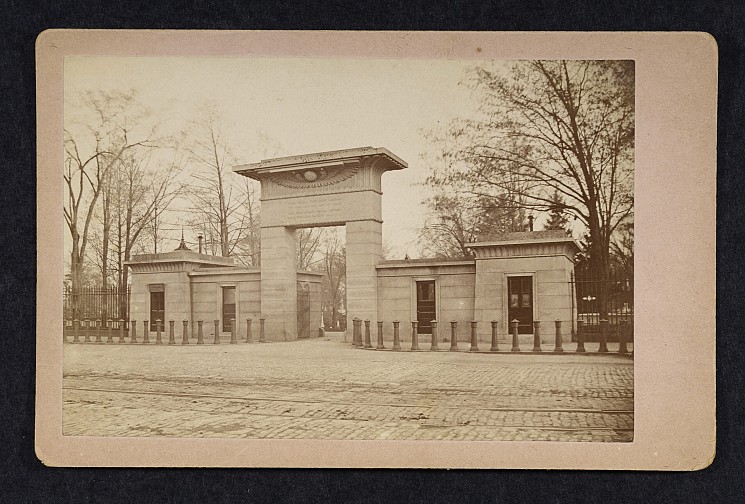
FROM THE ARCHIVES: MONUMENTS ON THE MOVE: Part I The Egyptian Gateway
By Kathleen M. Fox, Volunteer Researcher, Mount Auburn Historical Collections
People have been fascinated by how gigantic blocks of stone got moved ever since Stonehenge was discovered (built in 2500 B.C.), or the Egyptian pyramids (2550-2490 B.C.) or any number of churches and castles worldwide. Though not nearly as old, Mount Auburn has many very large stone monuments that cause us to ruminate on how they got to current their location. We’ve chosen two to write about. In each case they were made from a huge single block of granite, newspaper articles from the day provide details about their dimensions, and because the logistics for moving the granite would apply to other monuments in the cemetery. The first is the Egyptian Gateway. Though not a monument commemorating a specific individual, it is monumental.
How was the granite moved from the Quincy quarry? After being cut, quarrymen winched cables around the block of stone and moved it onto a wagon pulled by oxen. The image below of work being done at the at a quarry in Cape Ann illustrates the process.
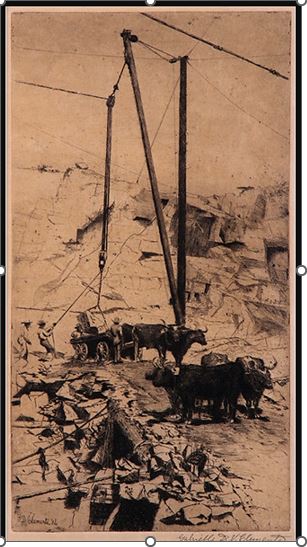
Harper’s Magazine March 1885 Vol. 70 #418.
This step was followed by a combination of ships, railroads, barges, and ox teams again. Such was the journey of the 55-ton block of granite quarried by Octavius T. Rogers & Co. at Quincy, Massachusetts for the capstone of the new Egyptian Gateway. The current granite gateway was built in 1842 to replace the original wooden gate of the same design that had been erected in 1832.
Octavius T. Rogers (1802-1859) was a prominent Quincy granite man. Because he had worked on the Bunker Hill monument, Harvard College Library, the Boston Merchant’s Exchange Building, and other Boston buildings, he may have been known to Jacob Bigelow through Bigelow’s social and business contacts. These included architect Gridley F. Bryant, who collaborated with Bigelow on designing Bigelow Chapel and Washington Tower. In 1826 Bryant designed a railway created to move granite for the Bunker Hill Monument from Quincy to Charlestown via the Neponset River. Financed by the “Granite Railway Company” founded by Thomas Handasyd Perkins (Lot #108 Central Ave.) it is considered the first commercial railroad in the U. S. [i]

Image: Warren S. Parker/www.digitalcommonwealth.org,
The Parker collection, Thomas Crane Public Library, Quincy Mass.
Rogers opened his own quarry, the “O. T. Rogers Granite Co.” on Willard Street in Quincy, in 1832. [i] (The current site of a Home Depot store). He won the bid for the entrance gate not only for his price ($9,535), but also because he was the only one who agreed to both quarry the stones and take on the logistics of assembling the gate on Mt. Auburn Street. [ii]
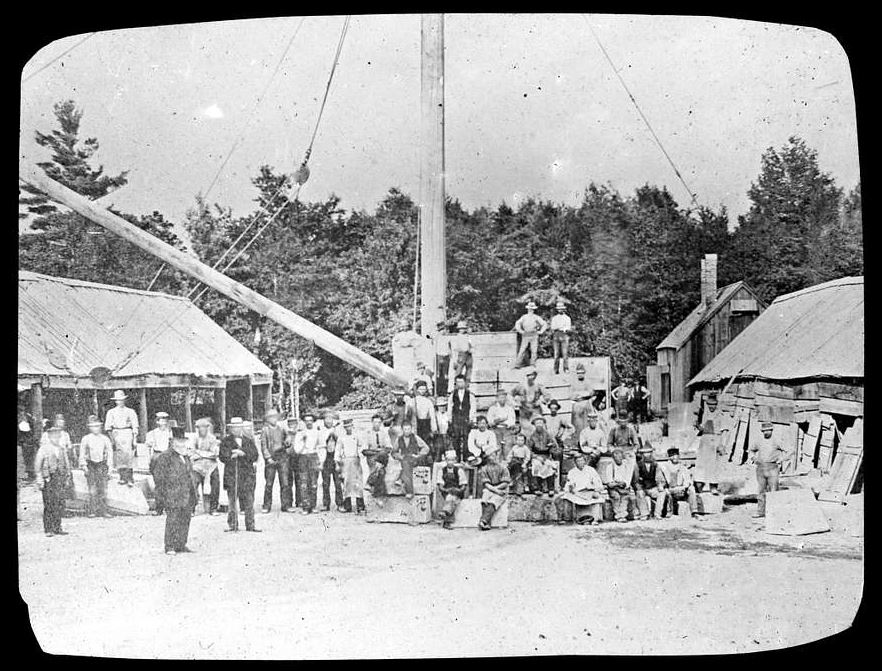
Image: Thomas Crane Public Library, Quincy Mass.
The first step for the Egyptian Gateway capstone was to transport it down to Gridley Bryant’s horse-drawn railway as shown in this illustration for the Bunker Hill stone:
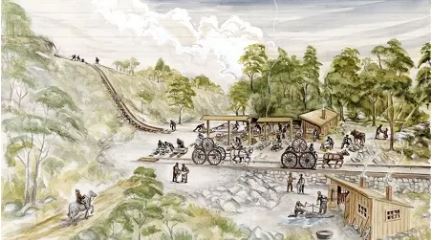
painting by V. Campbell, based on a drawing by Draper Hill.
Courtesy of the Quincy Historical Society
In 1843 the Boston Evening Transcript provided the dimensions of the Egyptian Gate stone, and details about how it was transported:
“…The capstone of the gateway is undoubtedly the largest block of granite ever wrought. It is 24 feet 6 inches in length, by 10 feet 9 inches in breadth, measuring to the outside faces of the abacus, and 4 feet 6 inches in height. The block from which this stone has been wrought, weighed, when first separated from the quarry, 130 tons. Its present weight is 55 tons. It was transported from Quincy to Watertown after being wrought, on a carriage… drawn by 45 yoke of oxen.” (Excerpt from the Boston Evening Transcript August 29, 1843.)
Once the railway delivered the stone to the Neponset River it would have been put on a ship for Boston Harbor. Arriving at the mouth of the Charles River it was then transferred to barges to bring it up river to a wharf in Cambridge. Finally, it was hauled by 45 yoke of oxen to the Cemetery. We can glean what this final stage may have looked like from the photograph below of the monument maker Alexander McDonald (on the right) moving a large block of marble by oxen.
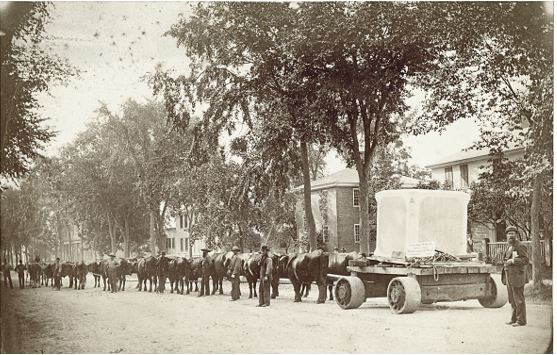
Image: Cambridge Historical Commission. Date unknown
(For more about monument Alexander McDonald see “Monuments on the Move” Part II.)
Upon arrival at the front gate, the capstone would have been hoisted in place by manually operated boom derricks, pulley jacks, hoisting jacks, and levers. Once in place the Egyptian Gateway itself became a landmark destination that it is today.
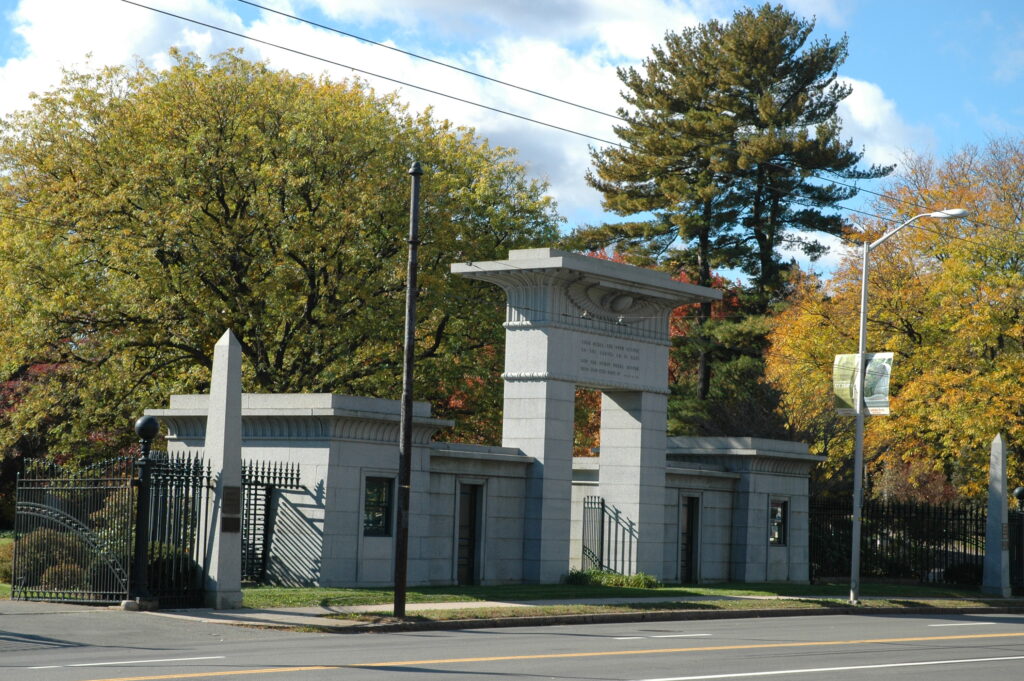
Stay Tuned for Monuments on the Move: Part II
SOURCES
Cambridge Public Library
Clukey, Sue North Yarmouth Rocks! An Overview of the Quarrying Industry. The North Yarmouth Gazette, July, 2006 Vol. 5, No. 1
Mount Auburn Cemetery Historical Collections
Teele, Albert Kendall Teele. The History of Milton Mass. 1640-1877
Washington, Nelson Dale. Department of the Interior U. S. Geological Survey. Bulletin #354 Chief Commercial Granites of Massachusetts, New Hampshire and Rhode Island. 1908
https://transportationhistory.org/
https://www.nps.gov/bost/learn/historyculture/bhm.htm
https://www.asce.org/about-civil-engineering/history-and-heritage/historic-landmarks/middlesex-canal
https://www.atlasobscura.com/places/granite-railway-incline
https://picryl.com/media/o-t-rogers-granite-cutting-sheds-0fd326
https://www.nps.gov/articles/000/building-the-bunker-hill-monument.htm
[i] https://www.freightwaves.com/news/freightwaves-classicspioneers-gridley-bryants-granite-railway-was-americas-first
[ii] Quincy Granite and its Manufacture in Stone, An Illustrated Magazine, v. 9 1894
[iii] December 6, 2011 https://www.mountauburn.org/egyptian-revival-gate/
Leave a Reply